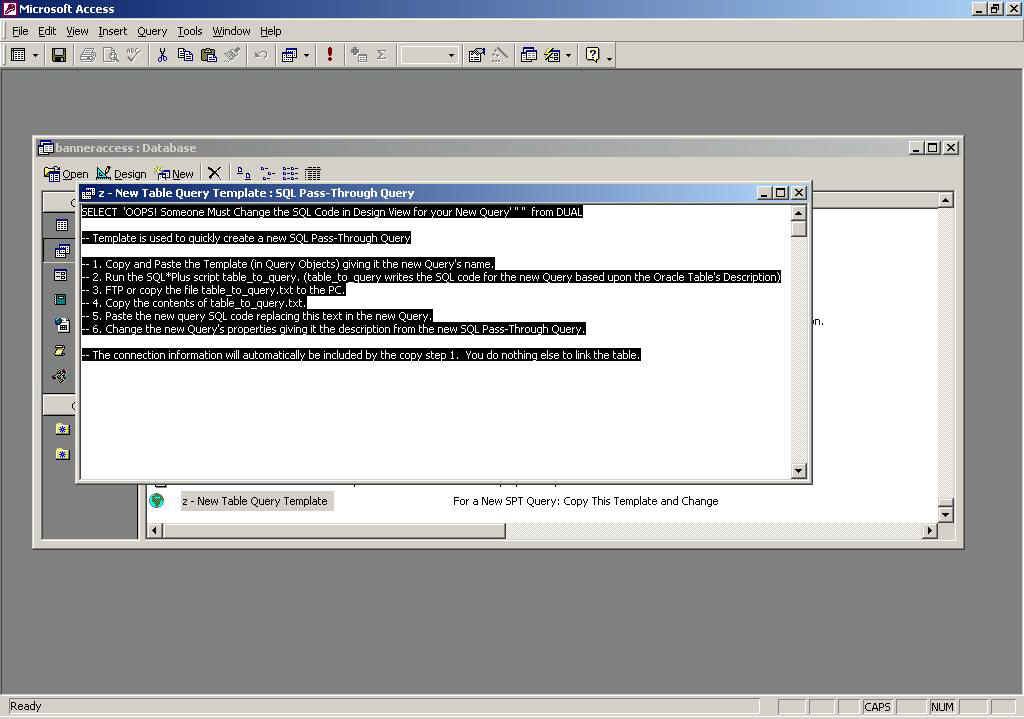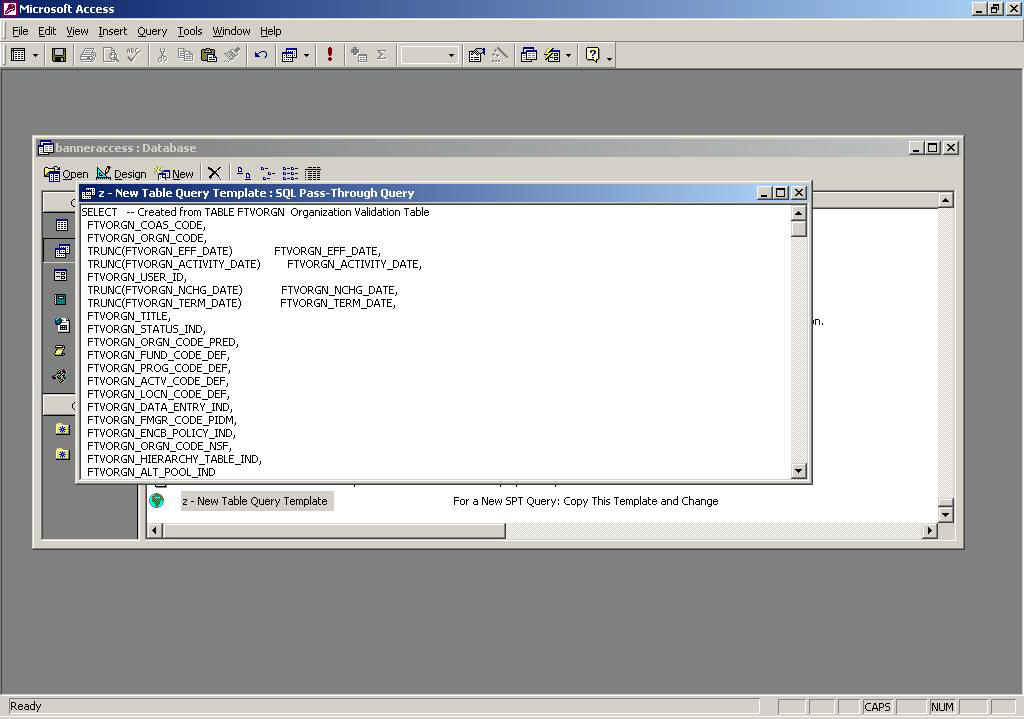by Bruce Knox bknox @t uaex.edu Oracle Database Programmer/Analyst date last updated 05/13/2009
Where do you get the code? Let Oracle Create your Code from the Data Dictionary.
Using
SQLPass-Though Queries for Banner Reporting
by Bruce Knox bknox
@t uaex.edu
Oracle Database Programmer/Analyst
date last updated 05/13/2009
![]()
Where do you get the
code? Let Oracle Create your Code from the Data Dictionary.
(Yes, the commented date is an error. We will get to that
soon.)

Paste
the generated code.


Yep, we knew that. BTW, this is one of the very most informative "ODBC -- call failed." messages I have seen. Most give no clue to the cause. I run my generated Queries in SQL*Plus to get a (usually) much better error message, but in this case the messages were the same.
-- AND TRUNC(FTVORGN_ACTIVITY_DATE) BETWEEN TO_DATE('07/01/2002 00:00:00','MM/DD/YYYY HH24:MI:SS') AND TO_DATE('06/30/2003 23:59:59'
,'MM/DD/YYYY HH24:MI:SS')'
We didn't remove the word wrap and the date was broken by the editor.
-- AND TRUNC(FTVORGN_ACTIVITY_DATE) BETWEEN TO_DATE('07/01/2002 00:00:00','MM/DD/YYYY HH24:MI:SS') AND TO_DATE('06/30/2003 23:59:59','MM/DD/YYYY HH24:MI:SS')'
{On a single line.}
Testing it:

The automatic Sort (ORDER BY) is great for a Banner table you will only be viewing, but mostly we will be combining our Queries with other Queries. In that case, sorting the component tables only slows you down (and everyone else on the server). There is no advantage in MS Access to having these component tables sorted.
So,
go back into Design and comments out the statement:
-- ORDER BY FTVORGN_ORGN_CODE
Note the many other commented statements. Some are for reference and others are just misguided suggestions:)
I never use defaulted Relationships in MS Access, because it slows down your startup processing. It seems like a great idea, but it doesn't work well with a complex database such as Banner. It is especially slow when used with SQL Pass-Through Queries.
This seems like a great deal to do, so it takes a long time anyway, right? Not at all. You can create a new Query using the above methods in 5-10 minutes. The routines that do this are generic and do not use specific Banner code. That means that it will completely work for SPRIDEN and will only give you a starting place for the most complex tables. But, it is a great starting point. Note that the routine takes care of the
TRUNC(FTVORGN_EFF_DATE) <= SYSDATE
AND (FTVORGN_NCHG_DATE > TRUNC(SYSDATE) OR FTVORGN_NCHG_DATE IS NULL)
AND (FTVORGN_TERM_DATE > TRUNC(SYSDATE) OR FTVORGN_TERM_DATE IS NULL)
logic that is seen in many of the validation tables. The default is to use the current date (<=SYSDATE) records, which is the most commonly used Query. For specific future or past dates, you will need to change the code.
The Date Columns are all
TRUNC(date_column) date_column
That makes all the dates have "as of beginning of day" time and
displays only the MM/DD/YYYY.
There are some cases where the Query must know the time; however, each of these requires special knowledge (i.e., the pattern is difficult to predict for Banner dates).
Next: At some point you need the Oracle Guys!
This is a personal site maintained by Bruce Knox ( bknox at uaex.edu ) documenting University of Arkansas, Division of Agriculture, Cooperative Extension Service IT projects.
Disclaimer
Use this information and these scripts at your own risk. As
a condition of using these scripts and information from this site, you agree
to hold harmless both the University of Arkansas Cooperative Extension
Service and Bruce Knox for any problems that they may cause or other
situations that may arise from their use, and that neither the Extension
Service nor I will be held liable for those consequences. The scripts and
information are provided "as is" without warranty, implied or otherwise.
Limitation of liability will be the amount paid to the University of
Arkansas specifically for this information. (It was free:)
Any University of Arkansas Division of Agriculture website Disclaimer terms
found in conflict with terms of this disclaimer shall over ride and replace
the conflicting terms found herein.
Other personal pages/sites that I
maintain:
http://www.openMosix.org the
website for the openMosix (Open
Source) Project hosted
on .
Note: The openMosix Project officially closed March 1,
2008. The source code and mail lists archives will continue to be
available on SourceForge as reference materials. Archive
Links are: FAQ HowTo Wiki SourceForge
Most of the works of art on my pages other than the Extension banner
 are
used by permission of J.
Wilson Spence.
are
used by permission of J.
Wilson Spence.
http://betwinx.com is
my personal site. betwinx?
This site is largely oriented to Oracle Reporting Solutions in the context
of generating bespoken reports from SunGard Higher Education's Banner
product. My university site is a more restrained version which cannot
contain endorsements of products or companies.
(I maintain a number of special topic pages with links from this primary
site.) ![]()
Near mirror at http://www.uaex.edu/bknox/ which is my university work site.
page mirror http://www.uaex.edu/bknox/Summit_2003_p08.htm Let Oracle Create your Code from the Data Dictionary.